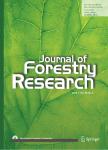Extraction of seed oil from Diospyros lotus optimized using response surface methodology
Extraction of seed oil from Diospyros lotus optimized using response surface methodology作者机构:Department of Chemical Engineering Faculty of Engineering University of Kashan Laboratory of Supercritical Fluids and NanotechnologyUniversity of Kashan
出 版 物:《Journal of Forestry Research》 (林业研究(英文版))
年 卷 期:2019年第30卷第2期
页 面:709-719页
核心收录:
学科分类:09[农学]
基 金:the University of Kashan especially the Deputy of Research for financial support (Grant: Pajoohaneh #1394/12)
主 题:Diospyros lotus Solvent extraction Physicochemical properties Fatty acids Response surface methodology
摘 要:Oil from seeds of Diospyros lotus was extracted using a conventional method with two different solvents:hexane and petroleum ether. A central composite design with response surface methodology were used to optimize the process. A second-order polynomial equation was employed, and ANOVA was applied to evaluate the impact of various operating parameters including extraction temperature(x_1; 44.9–70.1 °C), extraction time(x_2;5.0–10.0 h) and solvent to solid ratio(x_3;11.6–28.4 mL g^(-1)), on oil yield. Experiments to validate the model showed decent conformity between predicted and actual values. Extraction conditions for optimal oil yield were 61 °C, 8.75 h extraction duration and 19.25 mL g^(-1) solvent to solid ratio. Under these conditions, the oil yield was predicted to be 5.1340%. Oil samples obtained were then analyzed using gas chromatography. The fatty acid composition revealed the major fatty acids to be oleic acid(C18:1) and linoleic acid(C18:2). The analysis of oil also demonstrated a decent ratio between omega-3 and omega-6 fatty acids. The structure of seeds was imaged using scanning electron microscopy. Oil quality was analyzed thermogravimetrically and by Fourier transform infrared spectroscopy. The assigned nutritional features of the D. lotus oil suggested that it can be used as an edible oil in pharmaceutical and food industry in the future.



